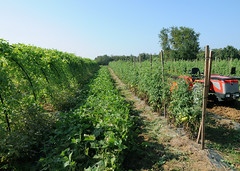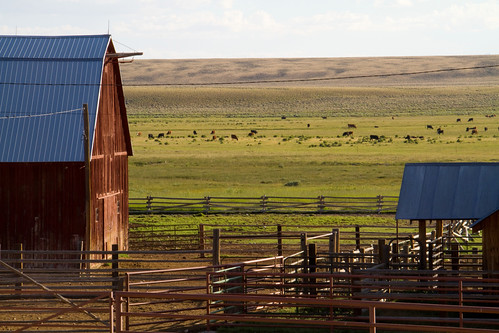Let's link the working rural landscape to the sustainability agenda (with Lee Epstein)

Posted March 1, 2012 at 1:25PM
Today's post is jointly authored with my friend and frequent collaborator, Lee Epstein. Lee is an attorney and land use planner working for sustainability in the Mid-Atlantic region.
There has finally been some overdue attention paid recently to the strengthening of rural communities to make them more economically and environmentally resilient. Ranson, West Virginia, for example, was the recipient of planning assistance last fall; Belfast and Lincolnville, Maine undertook a citizen-driven planning exercise, and the federal Environmental Protection Agency included a rural learning center in Howard, South Dakota (population 850) as one of its annual national award winners for smart growth excellence.
The emergence of smaller towns on the sustainability radar screen is a welcome development, but what of the working landscapes in between them? In an article on Maryland’s still mostly rural Eastern Shore, for example, we wrote that the continuing viability of the Shore - and of the landscape that makes the Shore so appealing to so many - depends on farming and fishing (as well as tourism), which economically are highly dependent on a lasting countryside.  One might make a similar case for places all over America. But, as we also wrote several months later, the smart growth movement seems to have gotten away from its early attention to rural America:
One might make a similar case for places all over America. But, as we also wrote several months later, the smart growth movement seems to have gotten away from its early attention to rural America:
“If you attend a meeting of smart growth and environmental advocates, or attend one of the major conferences on smart planning, you will hear relatively little about the loss of the landscape. Much of the conversation within the environmental community is now about rates of driving and associated emissions, particularly carbon – a critically important subject, to be sure – or perhaps urban ecosystems. But it’s a mistake, in my opinion, to neglect the effect of poorly planned development on land -- not only because of its importance to a number of significant environmental issues, but also because the landscape is part of our heritage, our shared culture. It is also the most visible consequence of sprawl, the one that people who are not professional environmentalists or urban wonks are most likely to notice and care about.”
A robust conversation has begun recently among smart growth advocates as to the future of our shared agenda, whether we continue to call our cause “smart growth,” “sustainable communities,” “strong towns,” or something else. In this article, we submit that rural America and its working landscape need to become a stronger part of that agenda.
We have had occasion of late to look for assistance and wisdom on this issue. But the wisdom has been a little thin, and the search a little frustrating. Don’t get us wrong: all of our wonderful smart growth and sustainability colleagues in the nonprofit world and government have been as cooperative and helpful as possible. The problem is that, from the national grant-making community to the various federal offices that provide research, guidance and, most importantly, grant assistance, the focus appears to be almost exclusively upon smart growth from the inside out.
That is, most of the white papers and booklets and financial assistance concentrate upon small, rural towns and the opportunities for strengthening them, but not much on what is happening beyond town boundaries. (One exception is a 2010 publication, Putting Smart Growth to Work in Rural Communities, produced by the International City/County Management Association and published by the Smart Growth Network.)
The relative lack of attention to the landscape - particularly working rural lands - is unfortunate. Small towns that are somewhat isolated by location from larger communities and the flow of commerce sometimes have difficulties keeping themselves whole – with very narrow employment opportunities for the middle class and for young adults of varying educational backgrounds and training, especially as various specific local industries take hits.  (See Carr and Kefalas, “The Rural Brain Drain,” in The Chronicle Review.) Many of these small town economies are not especially diverse, and when the one or two major local employers call it quits, the town’s fortunes dwindle. We wrote about the implications for three representative small towns - Fulton, Indiana; Chesnee, South Carolina; and Yreka, California - in 2010. Heck, Pine Point, in Saskatchewan, once home to 1200 people, vanished altogether, its community links now kept alive somewhat via online social networking; Wauconda, Washington was sold on eBay.
(See Carr and Kefalas, “The Rural Brain Drain,” in The Chronicle Review.) Many of these small town economies are not especially diverse, and when the one or two major local employers call it quits, the town’s fortunes dwindle. We wrote about the implications for three representative small towns - Fulton, Indiana; Chesnee, South Carolina; and Yreka, California - in 2010. Heck, Pine Point, in Saskatchewan, once home to 1200 people, vanished altogether, its community links now kept alive somewhat via online social networking; Wauconda, Washington was sold on eBay.
There are a variety of mechanisms for trying to reverse this phenomenon, used to greater or lesser success in rural communities across the country. Most seek to utilize “competitive advantage”-- economic assets of the town that are distinctive or exceptional, and upon which an economic development strategy can be built.
But addressing the issues can be anything but simple. Rural communities face more than just the problem of what to do to help the town as we usually think of it and, indeed, are made up of more than just the community’s built-up area: the open, working lands around the town are often under direct threat or assault by the likes of debilitating and sprawling low density development even in the light of overall population loss (as in Pennsylvania), or by industries (such as mining or energy development) that sacrifice the long-term productive or natural character of a place even if they temporarily pump money into it. Indeed, sometimes there may not even be much of a “town” at all, but rather a mere village or two amidst largely rural living in a largely rural county.
We believe the problem of rural open and working land loss is mostly being missed in current government discussions about assisting “rural smart growth strategies” (as we lamented late last year).  While we certainly agree (and have argued) that, to stem sprawl, rural towns must be strong enough to attract and hold residents, businesses, and investment, it is also crucial to protect the land surrounding the towns.
While we certainly agree (and have argued) that, to stem sprawl, rural towns must be strong enough to attract and hold residents, businesses, and investment, it is also crucial to protect the land surrounding the towns.
Indeed, rural communities often have a unique relationship with the rural land around them. Small town economies are not only strengthened when surrounding farms are successful, or when timbering or fiber industries (if practiced sustainably) continue to thrive; they can be defined by these relationships, and by the natural and working landscape around them. No contemporary philosopher has described this relationship better than did Wendell Berry, at least as it pertains to farming, in his seminal The Unsettling of America: Culture and Agriculture more than 40 years ago. Berry posited that we must not lose the understanding “…that as we and our land are part of one another, so all who are living as neighbors here, human and plant and animal, are part of one another, and so cannot possibly flourish alone; that therefore our culture must be our response to our place, our culture and our place are images of each other and inseparable from each other…”.
There are strategies available for helping to maintain and strengthen rural landscapes and working lands, and slowing the loss of farms and farmers, forest and other resource lands. As the ICMA report in part mentions, these can include “use value” taxation, purchase/transfer of development rights, assisting local farms with agricultural economic development such as direct farm-to-market programs, urban purchasing agreements, ecosystem services markets, right-to-farm laws and, crucially, extra low density zoning. Promoting conservation easements can also be important. Newly emerging strategies such as putting rural land to 21st-century nonpolluting uses with wind farms and biomass generation may also be promising in some areas.
It strikes us as particularly useful, however, for governmental entities such as the innovative federal Partnership for Sustainable Communities among HUD, EPA, and DOT not only to assist with studies, planning assistance, and related grants to the small, rural towns that are hard-pressed for planning expertise. Their work would be strengthened by recognizing equally the importance of sustaining the working lands surrounding those communities that, if lost, will disconnect them from their heritage, culture, and in most places, a substantial portion of their economy.
In commenting on a blog post, Chris Beck - senior projects adviser in the federal Department of Agriculture - observed that, to date, USDA’s liaison to the federal sustainability partnership has been through its rural development arm, not its conservation offices. But he also noted that “a number of the HUD regional planning grantees have indicated an interest in land conservation as a tool,” and that USDA's Farm and Rangeland Protection Program could be seen as a complementary strategy for implementing Partnership goals. Those are good ideas, and let’s build on them in future partnership activities.
In our view, smart growth and sustainability are about town and country, equally and alike, directly and indirectly linked. If we are to fully achieve our smart growth and sustainability objectives, we need to attend to both sides of this coin.
Move your cursor over the images for credit information.
Please also visit NRDC’s Sustainable Communities Video Channel.




